Amit Kumar Mishra
Amity University, Gwalior, India
CommSense: A Rapid and Accurate ISAC Paradigm
Jun 09, 2025Abstract:Future 6G networks envisions to blur the line between communication and sensing, leveraging ubiquitous OFDM waveforms for both high throughput data and environmental awareness. In this work, we do a thorough analysis of Communication based Sensing (CommSense) framework that embeds lightweight, PCA based detectors into standard OFDM receivers; enabling real-time, device free detection of passive scatterers (e.g.\ drones, vehicles etc.) without any extra transmitters. Starting from a realistic three link Rician channel model (direct Tx\(\rightarrow\)Rx, cascaded Tx\(\rightarrow\)Scatterer and Scatterer\(\rightarrow\)Rx), we compare four detectors: the full dimensional Likelihood Ratio Test (Full LRT), PCA based LRT, PCA+SVM with linear and RBF kernels. By projecting \(N\)-dimensional CSI onto a \(P\ll N\) principal component subspace, inference time gets reduced by an order of magnitude compared to the full LRT, while achieving optimal error rates i.e. empirical errors align tightly with the Bhattacharyya error bound and Area Under ROC Curve (AUC)\(\approx1\) for \(P\approx10\). PCA+SVM classifiers further improve robustness in very high dimensions (\(N=1024\)), maintaining AUC\(\gtrsim0.60\) at \(-10\)dB and exceeding 0.90 by 0dB even when full LRT fails due to numerical overflow. From the simulated result we have shown LRT based techniques are susceptible to the parameter estimation error, where as SVM is resilient to that. Our results demonstrate that PCA driven detection when paired with lightweight SVMs can deliver fast, accurate, and robust scatterer sensing, paving the way for integrated sensing and communication (ISAC) in 6G and beyond.
Dynamic Beam-Stabilized, Additive-Printed Flexible Antenna Arrays with On-Chip Rapid Insight Generation
May 15, 2025Abstract:Conformal phased arrays promise shape-changing properties, multiple degrees of freedom to the scan angle, and novel applications in wearables, aerospace, defense, vehicles, and ships. However, they have suffered from two critical limitations. (1) Although most applications require on-the-move communication and sensing, prior conformal arrays have suffered from dynamic deformation-induced beam pointing errors. We introduce a Dynamic Beam-Stabilized (DBS) processor capable of beam adaptation through on-chip real-time control of fundamental gain, phase, and delay for each element. (2) Prior conformal arrays have leveraged additive printing to enhance flexibility, but conventional printable inks based on silver are expensive, and those based on copper suffer from spontaneous metal oxidation that alters trace impedance and degrades beamforming performance. We instead leverage a low-cost Copper Molecular Decomposition (CuMOD) ink with < 0.1% variation per degree C with temperature and strain and correct any residual deformity in real-time using the DBS processor. Demonstrating unified material and physical deformation correction, our CMOS DBS processor is low power, low-area, and easily scalable due to a tile architecture, thereby ideal for on-device implementations.
Reliable Traffic Monitoring Using Low-Cost Doppler Radar Units
Mar 31, 2025Abstract:Road traffic monitoring typically involves the counting and recording of vehicles on public roads over extended periods. The data gathered from such monitoring provides useful information to municipal authorities in urban areas. This paper presents a low-cost, widely deployable sensing subsystem based on Continuous Wave Doppler radar. The proposed system can perform vehicle detection and speed estimation with a total cost of less than 100 USD. The sensing system (including the hardware subsystem and the algorithms) is designed to be placed on the side of the road, allowing for easy deployment and serviceability.
Agile Climate-Sensor Design and Calibration Algorithms Using Machine Learning: Experiments From Cape Point
Mar 09, 2025Abstract:In this paper, we describe the design of an inexpensive and agile climate sensor system which can be repurposed easily to measure various pollutants. We also propose the use of machine learning regression methods to calibrate CO2 data from this cost-effective sensing platform to a reference sensor at the South African Weather Service's Cape Point measurement facility. We show the performance of these methods and found that Random Forest Regression was the best in this scenario. This shows that these machine learning methods can be used to improve the performance of cost-effective sensor platforms and possibly extend the time between manual calibration of sensor networks.
Heart Disease Detection using Vision-Based Transformer Models from ECG Images
Oct 19, 2023Abstract:Heart disease, also known as cardiovascular disease, is a prevalent and critical medical condition characterized by the impairment of the heart and blood vessels, leading to various complications such as coronary artery disease, heart failure, and myocardial infarction. The timely and accurate detection of heart disease is of paramount importance in clinical practice. Early identification of individuals at risk enables proactive interventions, preventive measures, and personalized treatment strategies to mitigate the progression of the disease and reduce adverse outcomes. In recent years, the field of heart disease detection has witnessed notable advancements due to the integration of sophisticated technologies and computational approaches. These include machine learning algorithms, data mining techniques, and predictive modeling frameworks that leverage vast amounts of clinical and physiological data to improve diagnostic accuracy and risk stratification. In this work, we propose to detect heart disease from ECG images using cutting-edge technologies, namely vision transformer models. These models are Google-Vit, Microsoft-Beit, and Swin-Tiny. To the best of our knowledge, this is the initial endeavor concentrating on the detection of heart diseases through image-based ECG data by employing cuttingedge technologies namely, transformer models. To demonstrate the contribution of the proposed framework, the performance of vision transformer models are compared with state-of-the-art studies. Experiment results show that the proposed framework exhibits remarkable classification results.
A Propagation-model Empowered Solution for Blind-Calibration of Sensors
Jul 21, 2023Abstract:Calibration of sensors is a major challenge especially in inexpensive sensors and sensors installed in inaccessible locations. The feasibility of calibrating sensors without the need for a standard sensor is called blind calibration. There is very little work in the open literature on totally blind calibration. In this work we model the sensing process as a combination of two processes, viz. propagation of the event through the environment to the sensor and measurement process in the sensor. Based on this, we propose a unique method for calibration in two flavours, viz semi-blind and completely-blind calibration. We show limited results based on simulation showing encouraging results.
Analysis of Arctic Buoy Dynamics using the Discrete Fourier Transform and Principal Component Analysis
Jul 20, 2023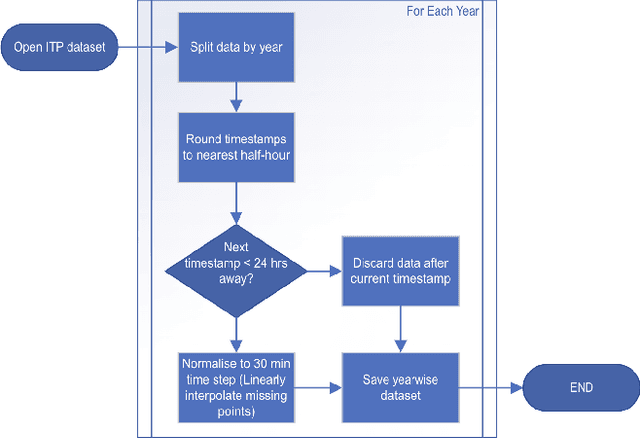
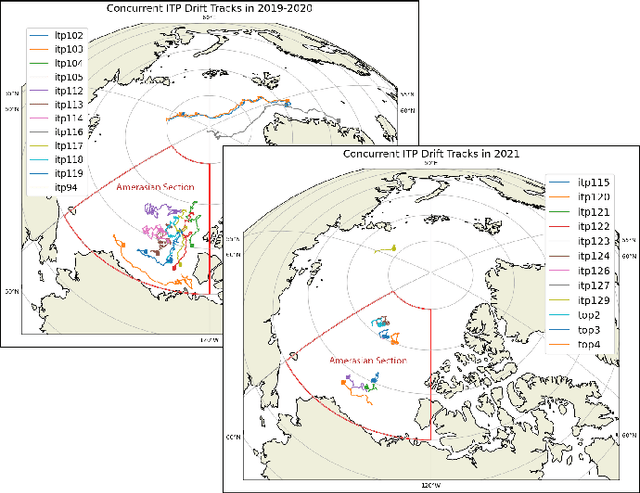
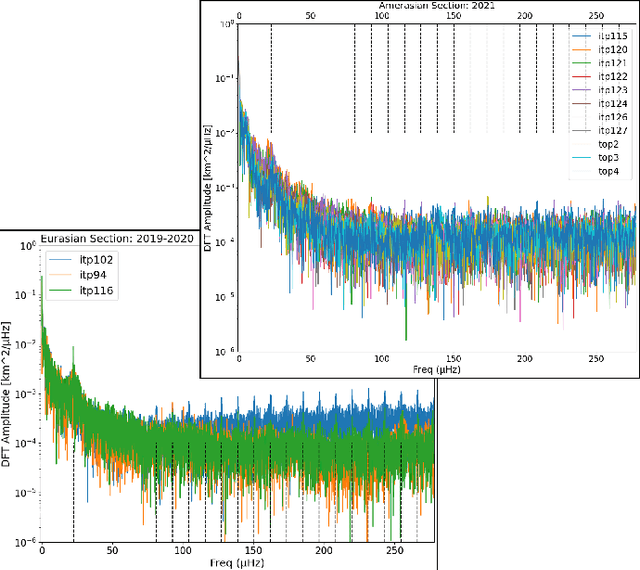
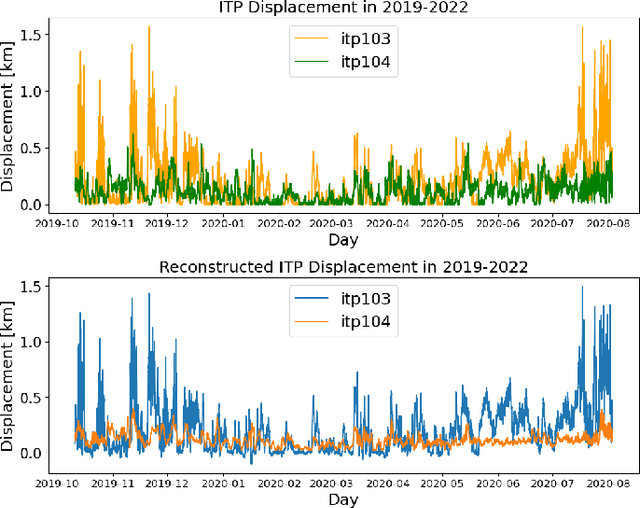
Abstract:Sea-Ice drift affects various global processes including the air-sea-ice energy system, numerical ocean modelling, and maritime activity in the polar regions. Drift has been investigated via various technologies ranging from satellite based systems to ship or ice-borne processes. This paper analyses the dynamics of sea-drift in the Arctic over 2019-2021 by Fourier Analysis and Principal Component Analysis of displacement data generated from the drift tracks of Ice-Tethered Profilers. We show that the frequency characteristics of drift support the notion that it is a function of both slowly varying processes, and higher frequency, random, forcing. In addition, we show that displacement data features high correlation between deployment locations and, consequently, suggest that there is scope for the optimisation of profiler deployment locations and for the reduction in number of instruments required to capture the displacement characteristics of drift.
Sensing the Environment with 5G Scattered Signals (5G-CommSense): A Feasibility Analysis
Jan 10, 2023Abstract:By making use of the sensors and AI (SensAI) algorithms for a specialized task, Application Specific INstrumentation (ASIN) framework uses less computational overhead and gives a good performance. This work evaluates the feasibility of the ASIN framework dependent Communication based Sensing (CommSense) system using 5th Generation New Radio (5G NR) infrastructure. Since our proposed system is backed up by 5G NR infra, this system is termed as 5G-CommSense. In this paper, we have used NR channel models specified by the 3rd Generation Partnership Project (3GPP) and added white Gaussian noise (AWGN) to vary the signal to noise ratio at the receiver. Finally, from our simulation result, we conclude that the proposed system is practically feasible.
Review of Methods for Handling Class-Imbalanced in Classification Problems
Nov 10, 2022
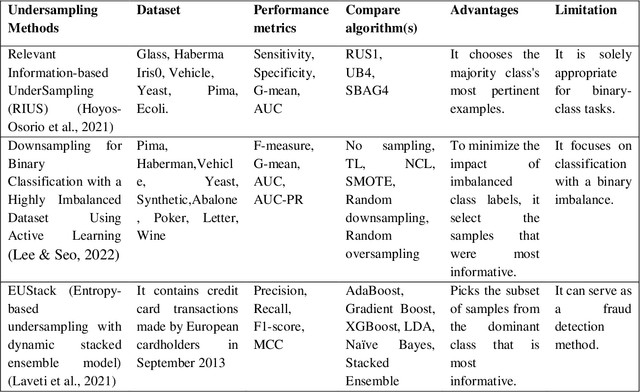
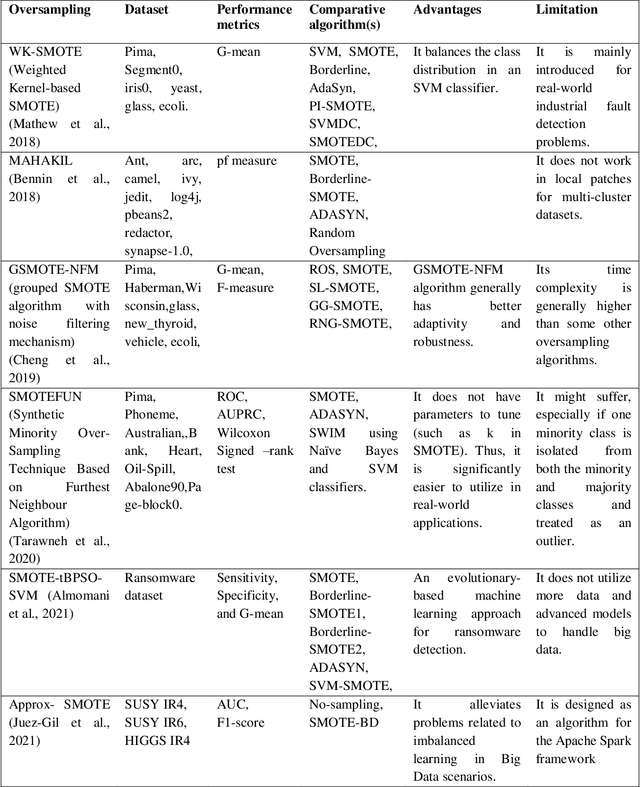
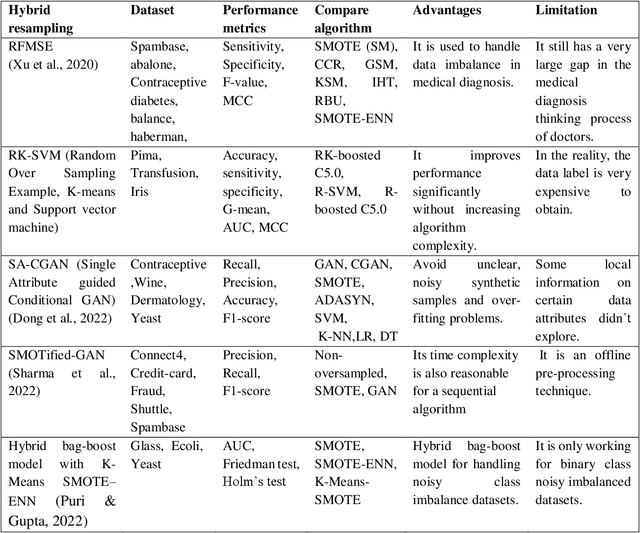
Abstract:Learning classifiers using skewed or imbalanced datasets can occasionally lead to classification issues; this is a serious issue. In some cases, one class contains the majority of examples while the other, which is frequently the more important class, is nevertheless represented by a smaller proportion of examples. Using this kind of data could make many carefully designed machine-learning systems ineffective. High training fidelity was a term used to describe biases vs. all other instances of the class. The best approach to all possible remedies to this issue is typically to gain from the minority class. The article examines the most widely used methods for addressing the problem of learning with a class imbalance, including data-level, algorithm-level, hybrid, cost-sensitive learning, and deep learning, etc. including their advantages and limitations. The efficiency and performance of the classifier are assessed using a myriad of evaluation metrics.
Machine Learning based Extraction of Boundary Conditions from Doppler Echo Images for Patient Specific Coarctation of the Aorta: Computational Fluid Dynamics Study
Sep 20, 2022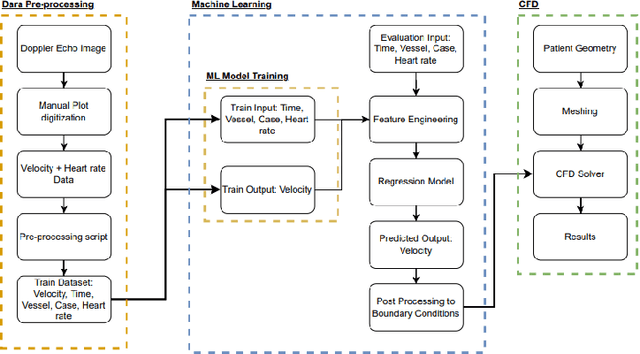

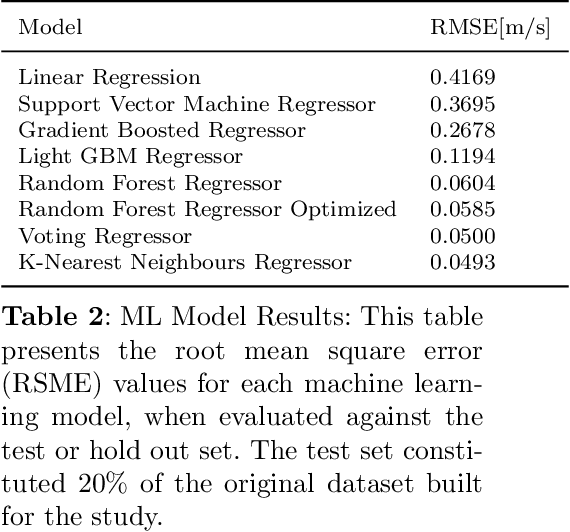
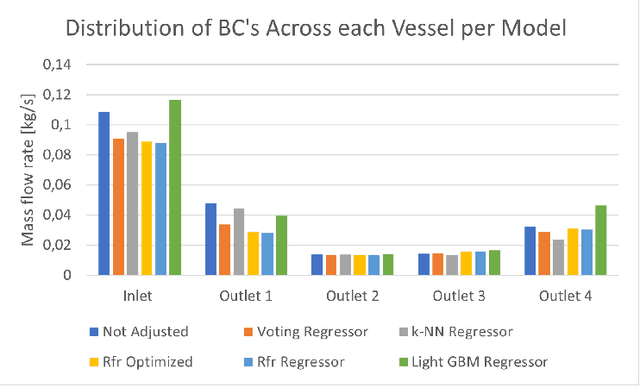
Abstract:Purpose- Coarctation of the Aorta (CoA) patient-specific computational fluid dynamics (CFD) studies in resource constrained settings are limited by the available imaging modalities for geometry and velocity data acquisition. Doppler echocardiography has been seen as a suitable velocity acquisition modality due to its higher availability and safety. This study aimed to investigate the application of classical machine learning (ML) methods to create an adequate and robust approach for obtaining boundary conditions (BCs) from Doppler Echocardiography images, for haemodynamic modeling using CFD. Methods- Our proposed approach combines ML and CFD to model haemodynamic flow within the region of interest. With the key feature of the approach being the use of ML models to calibrate the inlet and outlet boundary conditions (BCs) of the CFD model. The key input variable for the ML model was the patients heart rate as this was the parameter that varied in time across the measured vessels within the study. ANSYS Fluent was used for the CFD component of the study whilst the scikit-learn python library was used for the ML component. Results- We validated our approach against a real clinical case of severe CoA before intervention. The maximum coarctation velocity of our simulations were compared to the measured maximum coarctation velocity obtained from the patient whose geometry is used within the study. Of the 5 ML models used to obtain BCs the top model was within 5\% of the measured maximum coarctation velocity. Conclusion- The framework demonstrated that it was capable of taking variations of the patients heart rate between measurements into account. Thus, enabling the calculation of BCs that were physiologically realistic when the heart rate was scaled across each vessel whilst providing a reasonably accurate solution.
 Add to Chrome
Add to Chrome Add to Firefox
Add to Firefox Add to Edge
Add to Edge